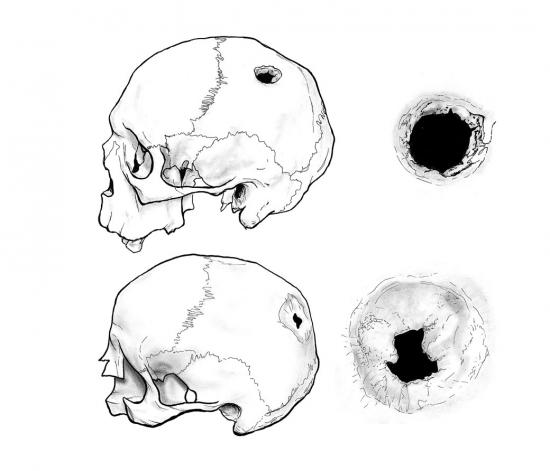Two trepanned skulls from the Middles Ages found in Spain
Source - http://www.pasthorizonspr.com/index.php/archives/05/2012/two-trepanned-skulls-from-the-middles-ages-found-in-spain

Trepanned skull: Image courtesy of Plataforma SINC
Two skulls with perforations have been exhumed in the area of Gormaz in Soria, Spain by researchers from the universities of Oviedo and Leon. They have been dated to the 13th and 14th centuries – a period in which trepanation was not commonly practised.
Trepanation, an ancient practice

Drawing of the two skulls and their trepanation (above is the female and below is the male). Image: Esther Gómez López
Trepanation has been around for a very long time. The earliest examples found go back to the beginning of the Neolithic Period some 10,000 years ago. There are even authors who suggest that such iatrogenic practices (induced by physicians) began at the end of both the Palaeolithic Period and the Mesolithic Period some 12,000 years ago.
Nonetheless, little evidence exists for later periods, such as the Middle Ages. The two skulls in Soria trepanned for medical purposes between the 13th and 14th centuries are therefore a surprising finding. They were discovered in the area surrounding the San Miguel hermitage in the area of Gormaz by researchers from the universities of Oviedo and Leon.
“As of the Bronze Age, cases of trepanation are common throughout Europe, mainly in the Mediterranean Basin. In the Iberian Peninsula there are many cases that have been dated back to the Copper Age some 4,000 years ago. However, our scientific literature lacks much more in the description of trepanation during the Middle Ages,” explains SINC Belén López Martínez, researcher and the University of Oviedo and co-author of the study.
One of the most salient cases actually comes from Spain. The King of Castile, Henry I (1204-1217) underwent trepanation whilst still alive possibly in an attempt to stop a haemorrhage caused by an accidental blow to the head. The accident subsequently brought him to his death.
The two skulls found in the cemetery in Soria belong to a male between 50 and 55 years and a woman between 45 and 50 years. The expert points out that “another interesting aspect of this finding is that trepanation in women is considered rare throughout all periods in history. In Spain, only 10% of those trepanned skulls found belonged to women.”
Different techniques, different results
The trepanation technique differs in each of the skulls. The skull of the male has been grooved with a sharp object and it is unknown whether trepanation occurred before or after his death. López Martínez confirms that “if the procedure took place whilst still alive, there is no sign of regeneration and the subject did not survive.”
In the woman, a scraping technique was used while she was still alive. According to the researchers, she survived for a “relatively long” amount of time afterwards given that the wound scarring is advanced.
Regarding why trepanation was performed, researchers suspect differing reasons. As the researchers conclude, “this is the big question on trepanation. Its practice can be attributed to many reasons: magic/religious reasons such as to free people from daemons that could be torturing them; initiations as a way of giving right of passage to adulthood or to turn someone into a warrior; therapeutic reasons to treat tumours, convulsions, epilepsy, migraines, loss of consciousness and behavioural changes and; the treatment of traumatisms like skull fractures.”
Source: Plataforma SINC
Full bibliographic information:
Belén López, Luís Caro, Antonio F. Pardiñas. “Evidence of trepanations in a medieval population (13th-14th century) of northern Spain (Gormaz, Soria)”, Anthropological Science 119(3): 247-257, 2011.